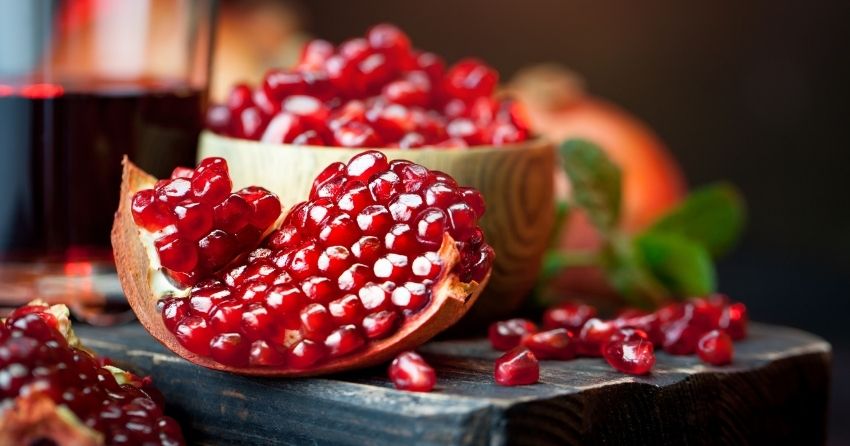Pomegranates, Nuts, and Berries Contain Compounds That Rejuvenate Aged Muscles

We typically become more sedentary with age. It just becomes that much harder to move around as we get older. This is because many of our muscles and the blood vessels that supply them weaken. In addition to staying active with age, we can take nutritional supplements to maintain our health and fitness.
One such supplemental candidate is urolithin A, a natural compound that has been used for thousands of years in holistic healing medicine and is a byproduct from the consumption of pomegranates, berries, and nuts. Although it’s been shown to improve muscle health, scientists aren't exactly sure how urolithin A is working.
Recently, a group of researchers from the School of Medicine at Indiana University has brought some clarity into the way urolithin A benefits the muscles. The team led by Nandini Ghosh, Ph.D., provided maiden evidence in a publication in Nature that supplementing mice with urolithin A bolsters levels of vital molecules involved in energy production and metabolism as well as pathways involved in the production of blood vessels and anti-aging in skeletal muscle.

Healing muscles through our bellies
Urolithins are made when our gut bacteria process natural compounds called ellagitannins, which are highly present in pomegranate, berries, guava, grapes, and nuts (pecans and walnuts). Also, urolithins are a mineral called Shilajit found in high mountain rocks, such as the Himalayas, that is used in traditional Ayurvedic medicine—one of the world's oldest holistic healing systems.
There are four kinds of urolithins (A, B, C, and D) found in humans, all of which are the metabolites of ellagitannins and ellagic acid. Urolithin A has anti‐inflammatory properties and is known for its antioxidant properties, meaning it removes toxins from your body and protects against harmful molecules known as free radicals. Importantly, it has been shown to improve muscle function. In aging rodents, urolithin A is known to benefit muscle function by increasing the process for recycling damaged mitochondria, the powerhouses of the cell.
Rejuvenating aging muscles by boosting blood vessel production
In this work, the research team led by Ghosh wanted to understand how we make use of urolithin A to aid aged skeletal muscle. They orally supplemented 12-week old mice with urolithin A for up to 16 weeks. The research team used 28-week old mice because they represent the human age of 34 to 42 years, which is about when age-related impairments in skeletal muscle start.
The researchers observed that markers of aging were elevated in the skeletal muscle of 28 week-old mice. But when they received urolithin A supplementation, these aging markers were significantly blunted in the skeletal muscle. This is consistent with prior reports demonstrating that urolithin A increases the life-span of worms.
When looking at what pathways muscles were being activated by urolithin A supplementation, the researchers saw gains in the levels of molecules that play a role in the development, growth, and replication of endothelial cells—the ones that line blood vessels.

Banking on the energy currency of life
The vital molecule nicotinamide adenine dinucleotide (NAD+) plays a central role in supporting skeletal muscle development and health. Aging depletes skeletal muscle reserves of NAD+, and depleted muscle NAD+ is a major threat to muscle health. Strategies to boost NAD+ under such conditions have produced encouraging results.
For the first time, Ghosh and colleagues showed that long-term oral supplementation of urolithin A is successful in bolstering skeletal muscle NAD+ of sedentary middle-aged mice. Elevated tissue NAD+ is linked with higher levels of ATP—the energy currency for life. Consistent with this observation, they also observed that urolithin A supplementation increased ATP content in mice muscle.
NAD+ fuels the function of many enzymes. One pertinent example is SIRT1, which is known for its anti-aging abilities. SIRT1 also has been shown to support signaling involved in blood vessel production. In this study, Ghosh and colleagues saw that SIRT1 was activated in skeletal muscle in aged mice supplemented with urolithin A.
When the researchers used a drug to activate SIRT1, they saw significantly improved endothelial function in aged mice. Similarly, when they supplemented aged mice with nicotinamide mononucleotide (NMN), a precursor of NAD+, they also saw the activation of SIRT1 and ameliorated endothelial function in blood vessels.
The ongoing fight for muscle health
Aging impairs skeletal muscle function by depleting ATP, NAD+ levels, and weakening blood vessels. This work directly showed that long-term oral urolithin A supplementation enhanced skeletal muscle ATP and NAD+ levels and turned on blood vessel producing pathways in skeletal muscle via a SIRT1 pathway.
This research lays the foundation for future work testing the effect of urolithin A supplementation on the progressive and generalized loss of skeletal muscle mass and strength that is strictly correlated with a physical disability, poor quality of life, and death.
References:
Ghosh N, Das A, Biswas N, et al. Urolithin A augments angiogenic pathways in skeletal muscle by bolstering NAD+ and SIRT1. Sci Rep. 2020;10(1):20184. Published 2020 Nov 19. doi:10.1038/s41598-020-76564-7





